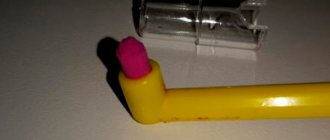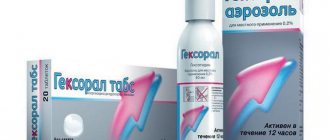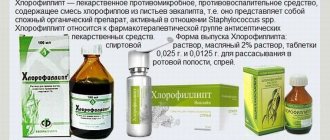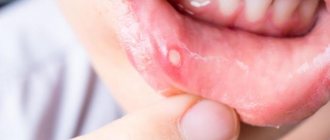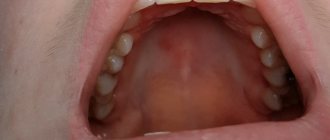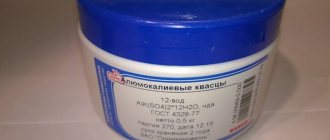Burnt alum for stomatitis
Alum has been known in human history for thousands of years, and the use of this substance is varied and used in various industries. The great ancient historian Pliny himself described them in his works “Natural History”. Alum is a cloudy white mineral with a crystalline structure in the shape of an octahedron with a sour, astringent taste and no obvious odor. Chemical composition – double salts crystal hydrates of three and monovalent metals MAL(SO4)2•12Н2О. In nature, this mineral is rarely found in its pure form; its production consists of two stages, alunite ore was extracted by the mining industry and then using a complex technological process to obtain an enriched concentrate. But since alum was not stable and was subject to external negative environmental influences, which reduced its valuable qualities. This problem was solved by dehydrating this substance using heat treatment, and this is how burnt alum appeared.
A little about stomatitis. In a nutshell, stomatitis is an inflammatory disease of the oral mucosa. It is expressed in the form of inflammation on the gums, cheeks, lips, tongue and palate, and also manifests itself as allergic rashes, wounds and blisters. The causes can be mainly divided into three groups, the first is mechanical damage to living tissues of the oral cavity. These may include exposure to food products during eating, and also as a result of careless handling of various foreign objects. This group also includes violation of personal hygiene rules for dental care. The second, broader group includes all sorts of secondary factors that are not directly related to a specific place, but are directly related to a given place. This includes allergies of various types and categories, diseases of various organs separately, and disorders of the entire immune system as a whole. And finally, the third group is associated with the use and overdose of medications or their individual components.
Description
Burnt alum is a unique substance created on the basis of traditional potassium aluminum samples. To obtain them, the starting material is heated to 160 degrees Celsius, after which it is evaporated until 50% of the original volume is lost.
As a result, it is possible to obtain an absorbent, odorless, white powder, distinguished by its shape in the form of small crystals.
The finished product has the following effect:
- antibacterial;
- drying;
- hemostatic;
- cauterizing;
- enveloping.
In addition, alum quickly eliminates itching and other discomfort. As a result, help with stomatitis is guaranteed in every case.
Indications and contraindications
Alum is useful for almost any form of stomatitis. The exception is the herpetic form of stomatitis, since the drug is not used as an antiviral agent. When treating herpetic stomatitis, additional antiviral drugs are recommended.
Burnt alum powder
Usually, alum is prescribed for complex therapy in order to create a protective film, which can help reduce pain, discomfort, weaken salivation, and create a basis for protecting the epithelium from secondary infections.
Alum is successfully used not only in the treatment of stomatitis, but also in many other cases:
- injuries to the oral mucosa that were caused by accidental biting of the lips, tongue, inner surfaces of the cheeks, or damage to soft tissues;
- bleeding from wounds in the oral cavity.
Adults can dilute alum at the rate of a full teaspoon per glass of boiled water.
There are no contraindications to the use of alum. The manifestation of allergic reactions is practically not observed.
Burnt alum for the treatment of stomatitis
Burnt alum is a dehydrated mixture of sulfate salts of aluminum and potassium, widely found in rocks and clay soils. In addition to potassium alum, crystalline hydrates of sulfates of other alkali (sodium, strontium) metals and trivalent (molybdenum, iron) metals are found, but aluminum and potassium compounds are most widely used in industry, the production of cosmetics and medicine. Dehydration of natural alum occurs when the material is heated to +160° for several hours. The result is a chemically inert hygroscopic powder or mass of white or gray color. Alum is practically odorless and sour in taste.
Healing properties of alum
The biological activity of burnt alum is due to its ability to denature animal and plant proteins and absorb excess fluid accumulated on the skin and mucous membranes.
Since time immemorial, burnt alum has been used in folk medicine as an astringent, hemostatic, drying and antimicrobial agent. In the old days they were used to sprinkle burns and purulent wounds. Today, alum is most widely known as a cure for hyperhidrosis - excessive sweating.
Alum at the same time absorbs excess secretions from the sweat and sebaceous glands (for example, under the armpits, in the inguinal folds, between the toes, under the mammary glands in women), and also suppresses the fungal and bacterial microflora that actively develops in these places and causing skin irritation and a characteristic unpleasant odor. Not everyone knows that it is not so much human sweat itself that smells disgusting, but the product of its processing. A few minutes after sweating, fungi and bacteria living on the skin begin to actively act. By treating your skin with burnt alum, you can get rid of the problem of hyperhidrosis for several hours. Regular treatment gradually suppresses pathogenic microflora and will allow you to cope with the problem forever.
Alum for stomatitis
The astringent (tanning) and disinfecting effect of burnt alum is also quite widely used in the treatment of stomatitis and other inflammatory diseases of the oral cavity, including in children.
Alum is practically non-toxic, swallowing it in small quantities does not cause any harm to the body, and in the mouth it quickly does its good work, suppressing the proliferation of microbes and fungi of the genus Candida, forming on the surface of the mucous membrane the so-called albuminate - a film of coagulated proteins.
It protects the surface of the epithelium affected by stomatitis from mechanical stress and secondary infection, and can eliminate bleeding gums and minor bleeding that are inevitable when peeling off the crusts characteristic of herpetic and ulcerative stomatitis.
After treatment with alum, damaged areas stop bleeding within a few minutes, and the film eliminates pain when eating and talking. Babies who have had their mouths treated with an alum solution almost immediately stop crying and being capricious.
The use of alum for stomatitis
It is very simple to prepare a mixture for treating the mucous membranes of the oral cavity. For a glass of boiled or filtered water at room temperature, take half a teaspoon of burnt alum.
The powder is thoroughly mixed. Due to additional hydration, foam may form in the glass, and the contents may acquire a starchy consistency - this is not a big deal.
The contents of the glass taste sour and astringent, like persimmon.
You should rinse your mouth 5-7 times a day for 1-2 minutes. For children who do not yet know how to rinse their mouth on their own, treat it with a gauze swab 3-4 times a day, and apply the solution to both sick and healthy areas. This will help prevent infection from spreading in your mouth.
Treatment is continued for five to seven days until the bacterial or fungal plaque, erosions and ulcers completely disappear. For herpetic stomatitis, alum is ineffective as an antiviral agent, but it can be used in combination with an antiviral agent.
In complex therapy, they form a protective film of albuminate in the mouth, which reduces pain, weakens salivation and protects the epithelium from secondary infections.
Alum is successfully used for injuries to the oral mucosa resulting from accidental biting of the lips, tongue, inner surfaces of the cheeks, damage to soft tissues as a result of an impact, unsuccessful attempts to chew hard food, etc. If blood is flowing from a wound in the mouth, it is enough to rinse your mouth with a solution of burnt alum and the bleeding will stop. Adults can dilute alum at the rate of one full teaspoon per glass of water - this will not make it worse.
Treatment regimen
Alum is one of the fastest ways to get rid of stomatitis.
Natural powder leads to the appearance of a colloidal film, which promotes rapid tissue healing.
At the site of application, burnt alum (instructions for use for stomatitis will be discussed in detail below) forms albuminate or the so-called colloidal film.
It is able to protect nerve endings, which significantly reduces pain, itching, as well as tension and burning of existing wounds.
The powder has astringent, anti-inflammatory, and drying effects.
The colloidal film tightens the wound, so the ulcer is protected, stops bleeding and heals much faster. Burnt alum for stomatitis acts as follows:
- the formation of colloidal films on the surface of wounds or ulcers after treatment due to a chemical reaction with pathogen proteins during interaction;
- blocking nerve receptors responsible for pain, itching and burning;
- When applied directly to wounds, the blood stops, the edges dry out and tighten.
At the first stage of the disease, timely treatment of the affected areas with burnt alum helps prevent the development and deepening of ulcers, which will prevent the disease from developing.
Therefore, it is better to apply the medicine directly to the wounds. This will prevent the spread of infection inside/outside the oral mucosa. With targeted treatment of aphthae, the healing process is faster and pain is significantly reduced.
When using alum in a complex treatment regimen, it is possible to use it as local lotions and rinses. It is recommended to first disinfect the oral cavity and clean the wounds.
How to use burnt alum for stomatitis
Instructions
Burnt alum is a derivative product from ordinary potassium-aluminum alum. They are heated to 160°C and half of the original volume of raw materials is evaporated. The remaining alum is ground into powder, obtaining a crystalline, odorless, absorbent product.
Burnt alum has antibacterial, drying, cauterizing, enveloping and hemostatic properties. In addition, the product relieves itching, which is important for stomatitis.
How does burnt alum work for stomatitis? Their effectiveness is due to the ability to form albuminates on the surface of ulcers - colloidal films that “freeze” the nerve endings. As a result, the pain subsides, itching and burning go away. Alum can be applied directly to oozing areas, as it stops bleeding, drying and tightening the edges of the wounds. In the initial stages, treatment of stomatitis with burnt alum is good because it stops ulcers, preventing the disease from developing. Therefore, it is recommended to apply alum locally to wounds so as not to spread the infection throughout the entire oral cavity. In addition, the spot application of alum on aphthae promotes their speedy healing and rapid reduction of pain.
For complex treatment, you can combine local lotions and rinses. Just first you need to treat all the wounds, and then, when the foci of infection are disinfected, rinse the entire oral cavity.
For spot treatment of ulcers, dry alum is needed. They are used as regular powder. You just need to take a little powder with the tip of a clean finger and apply it to the canker sores.
To prepare the solution, you need to take 200 ml of boiled water at room temperature and 4-5 g of burnt alum. Stir until the crystals are completely dissolved. Then taste the solution - it should resemble water acidified with lemon, and at the same time be very tart and astringent. Store for no more than two days in a cool, dark place, but not in the refrigerator.
Use burnt alum for stomatitis as a rinse every two to three hours. Pre-treat the sores locally. Stir the solution before use.
If it is difficult to combine the treatment of stomatitis in a small child by spot treatment and rinsing, you can treat his wounds with a concentrated solution. For 200 ml of water, take not 5, but 10 g of alum. Apply the solution to cotton pads and wipe the inside of the palate and cheeks.
Sources:
- The use of burnt alum for stomatitis
Instructions for use
Alum is used as a mouth rinse for stomatitis.
To prepare the solution, add 0.5 tsp to a glass of boiled water. powder and stir it thoroughly.
In this case, the consistency of the solution becomes slightly viscous (like laundry starch), and the taste becomes sour. Should be used 5-7 rubles/day, duration of procedure is 1-2 minutes.
The use of the solution for the treatment of stomatitis in children is not prohibited, but the application pattern is modified: it is necessary to lubricate the oral cavity with a cotton swab 3-4 times a day and for 30-40 minutes. After the procedure, refrain from eating and drinking.
Alum for stomatitis in a child: how to use burnt alum, rosehip oil and aloe for mash
Stomatitis refers to a whole group of unpleasant ailments of the oral cavity of various origins: some of them are viral and fungal. They often develop as a consequence of fungal or viral diseases of the whole body, or due to poor oral hygiene.
The common symptoms are: ulcers in the mouth, redness of all mucous membranes, pain. Hyperemia of the mucous membranes and increased temperature may also be observed. For treatment, you need to improve your immunity and overall health, and also consult a dentist.
But folk remedies for stomatitis can also help. In what cases and what, read below.
In what cases is treatment with folk remedies possible?
The most effective folk remedies for the treatment of catarrhal stomatitis, which makes itself felt “thanks to” sensitive mucous membranes and dry mouth, as well as ulcers on the gums or tongue.
External factors are to blame (incorrectly installed dentures, smoking, injuries), so if the external cause is eliminated and herbal therapy is used, the unpleasant sensations will quickly disappear.
But for aphthous stomatitis, herpetic stomatitis and those caused by mycoses, specialized pharmaceutical products are needed. They are prescribed by a dentist, or better yet, a periodontist. However, they can be combined with folk ones.
Folk remedies are also appropriate if you are allergic to prescribed medications. They can also be used to treat stomatitis in young children. But do not forget that such products are also medicines, which means they require compliance with the dosage, experience, knowledge and consistency of use.
Oils
They are known for their antimicrobial effects, as well as their anesthetic and healing properties. You can use both essential oils and sea buckthorn. In some cases, olive and others are appropriate.
Rules for selecting oils and application
Essential oils are best used to stop inflammatory processes, and sea buckthorn oils are best used to heal ulcers after inflammation has subsided. They can be used either as a rinse or simply applied to ulcers and other lesions on the mucous membrane.
If there is no sea buckthorn oil, or you are intolerant, you can replace it with others: olive, peach, flaxseed or rosehip oil will do. Of course, they need to be applied to disinfected mucous membranes and not with your hands, but with a cotton swab. You can first wipe your mouth with dry cotton wool.
The best of the best
The following essential and vegetable oils are most effective:
- tea tree. Not only is it a good antiseptic, but it also dries and relieves pain in the mouth;
- lavender. It also dries and kills microbes, relieves inflammation, and has some fungicidal properties;
- eucalyptus. It has local irritating abilities, normalizes blood circulation in the mouth, relieves discomfort, fights bacteria;
- sea buckthorn oil for stomatitis. Heals any damage as it is rich in retinol.
For rinsing, you can use the following mixtures of oils:
- a drop of Roman chamomile, myrrh and eucalyptus oils, plus two drops of lavender and tea tree;
- a drop of lavender and eucalyptus, two drops of tea plus a teaspoon of baking soda.
Dissolve in half a glass of purified water. The water must be warm. We rinse 3-4 times a day. It's better to do this after a meal.
For applications, mix tea and lavender oils with vegetable oil (any kind), pour it onto a cotton swab and apply to the gum for a third of an hour.
Young children who do not yet know how to rinse their mouths can only apply oils to the sores in a small amount.
Lotions, rinses
The rinse solution is prepared as follows:
- take the following ingredients: a glass of boiled water, 4-5 g of burnt alum;
- mixing until the crystals are completely dissolved;
- store the solution for no more than two days in the refrigerator;
- The liquid must be stirred before use.
To cure stomatitis in a child, you can use the method of spot treatment of ulcers with a concentrated solution.
To obtain the working fluid, you need to take 10 g of alum per glass of water. The solution is applied using cotton pads and rubbing.
The resulting solution should be used every 3 hours by rinsing. Afterwards it is recommended to treat the ulcers locally.


